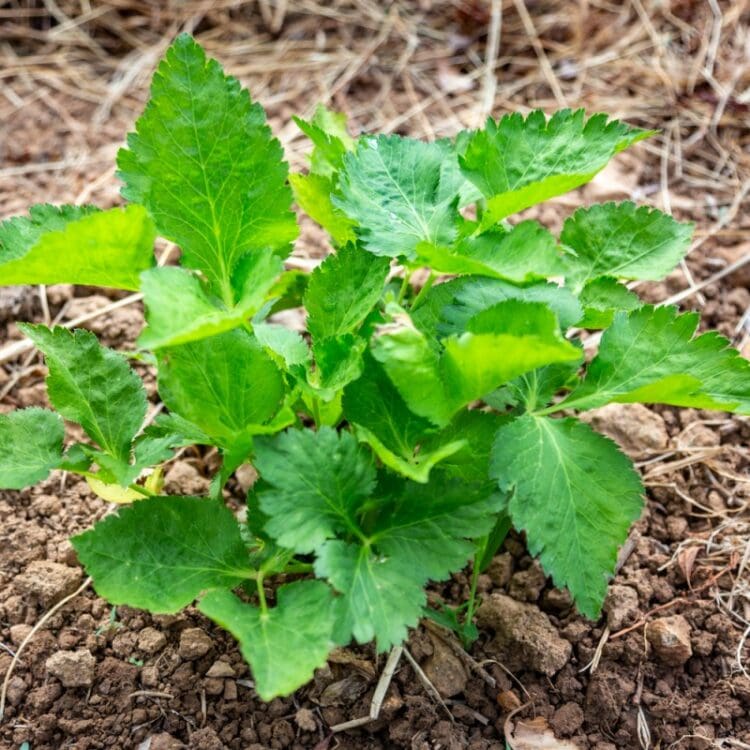It could almost be mistaken for parsley. Mitsuba, well-known in Japanese cuisine, has nothing to envy its western counterpart. I would even say it can be a beautiful discovery for herb enthusiasts!
What Is Mitsuba?
“Mitsuba” literally means “three leaves” in Japanese. It is also sometimes called “Japanese wild parsley”, “Japanese St. John’s wort”, “stone parsley”, “Japanese parsley”… As you can see, it’s an aromatic herb with large green leaves that the Japanese use in soups, dumplings (in the dough of gyoza, for example!), noodle dishes, and salads.
It is also used as a garnish in many dishes such as Oyakodon. A bit like classic parsley, you might say… Except that mitsuba has a slightly more distinctive flavor profile than Italian parsley, although they belong to the same botanical family.

Where Does Mitsuba Come From?
Mitsuba grows mainly in the wild in Japanese, Chinese, and Korean forests. In its natural environment, the plant can reach about one meter in height, a bit less when cultivated in gardens.
In Japan, it has been popular for hundreds of years already, both as a flavor element and as a shade plant. According to tradition, it is also supposed to bring luck to newlyweds. It’s therefore not surprising to see a few stems of mitsuba decorating tables and dishes, as well as the bride’s bouquet.
What Does Mitsuba Taste Like?
In terms of flavor, there are taste similarities between mitsuba and flat-leaf parsley or chervil. It’s fresh, delicate, and slightly lemony. Mitsuba has the particularity of presenting notes of celery, angelica, and coriander. With the nice weather returning, it’s the ideal combination. When cooked, mitsuba loses its flavors and becomes more bitter than anything else.
So, indeed, it is preferable to consume it raw. However, in case you were wondering, mitsuba is very rarely found in its dried form. It is more commonly used fresh. For a beautiful garnish like this, it’s anyway better — even visually, to use it still fresh and lively, still rich in its flavors.
Mitsuba and Minari, What’s the Difference?
It’s also possible to confuse mitsuba and minari. Indeed, these are herbs that we must distinguish, especially in terms of taste. Mitsuba is a light herb with notes of celery and sorrel. Minari, on the other hand, is more aggressive.
It is often compared to green pepper. Moreover, the latter is a water plant, while mitsuba grows in wooded environments. So, nothing comparable.
How to Use Mitsuba in Cooking?
It’s worth knowing that the entire mitsuba plant is edible; from the root to the leaf. Even the seeds and stem, so don’t throw them away. We often sprinkle a few sprigs of mitsuba in quick dishes that don’t require a lot of preparation, like salads, to add an extra touch of freshness.
You can also sprinkle mitsuba leaves in noodle dishes, rice, sushi or “egg-based dishes, like tamagoyaki or”oyakodon. Be sure to use it at the end of preparation and especially not to cook it, otherwise it releases a rather unpleasant bitterness.
In Japan, mitsuba is often used to brighten up miso soup or enhance the taste of donburi, chicken or fried pork dishes. It’s also what’s put in the small bread accompanying the bowl of ochazuke, a traditional Japanese dish composed of rice and tea.
How to Replace Mitsuba?
Not surprisingly, mitsuba can be replaced with flat-leaf parsley. It’s one of the best substitutes. Otherwise, you can also use chervil, celery leaves, chopped coriander…
Where to Find Mitsuba?
You will more easily find mitsuba in specialized grocery stores. It’s a plant that is not yet well-known in Europe, so it’s better to stick to reliable sources.
Moreover, this approach is more likely to guarantee you an authentic product. It’s often sold with the roots still attached, so don’t be surprised. It seems that you can even grow it at home with adequate light and shelter, and a mixture of potting soil, sand, and seedling mix.
How to Store Mitsuba?
Mitsuba with its stems and roots can be stored in a pot filled with water (like a bouquet of flowers) in the refrigerator. If you decide to cut it all, you can wrap it in slightly damp towels in the vegetable drawer. You can keep it for about a week depending on the freshness of the product.

